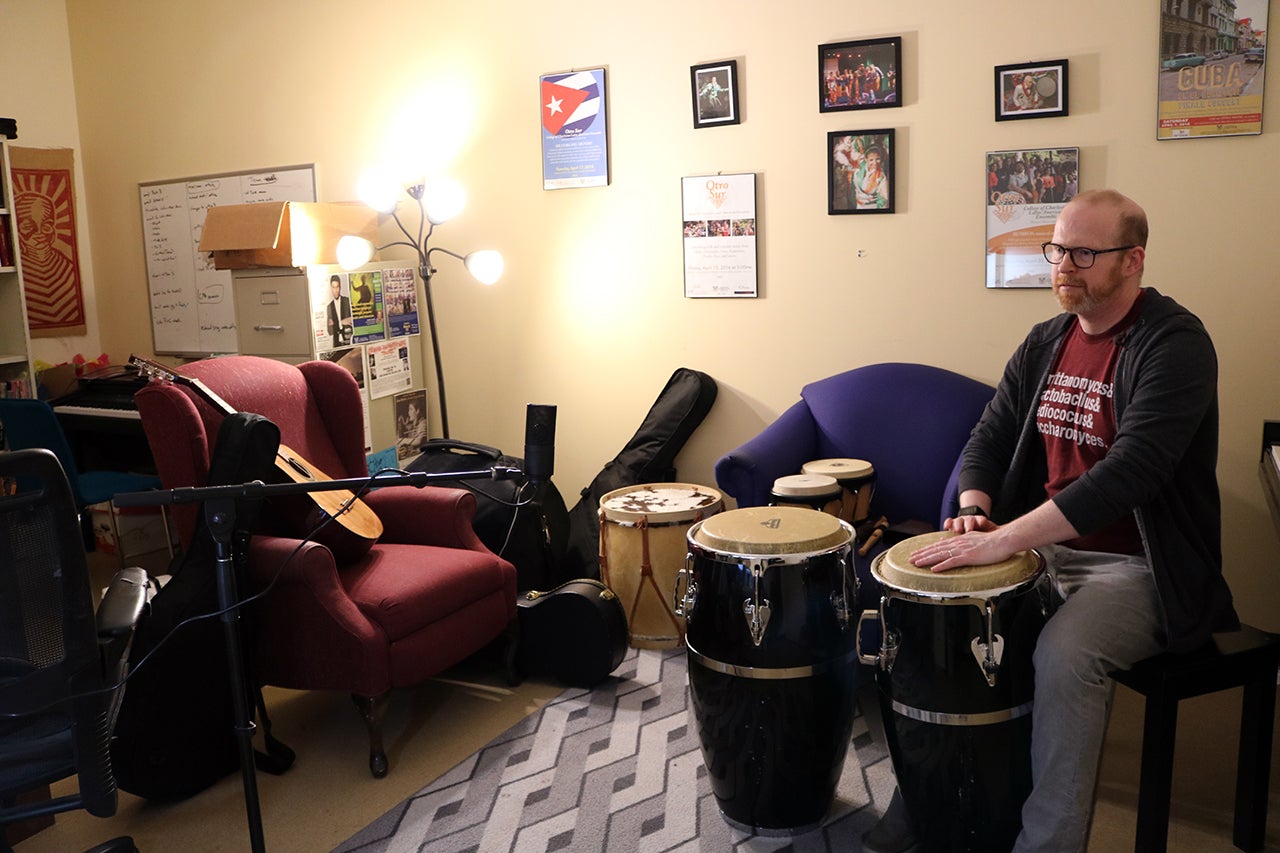The tinny ring of the bongos reverberates throughout music professor Michael O’Brien’s office. With a methodical thumping of his hands, O’Brien demonstrates the rhythmic beats of Cuban music for students in his Music of Latin America class. Except, the students aren’t there: O’Brien is recording the instrument for a lesson students will take next week as the College of Charleston begins two weeks of e-learning amid the coronavirus pandemic.
“As it happens, we’re reaching the part of the semester in two of my classes where we’re studying music that I have experience of as a professional performer, so in my Music of Latin America class, I’ll be including some video of simple demonstrations of playing techniques on percussion instruments used in Cuban songs and salsa (congas, bongo, timbale),” says O’Brien. “In my Music as Culture class, there will be a lecture on tango music in Argentina, where I’ll include some short demos of me playing the bandoneón.”
While the College offers an array of online courses every semester – including the fully online Master of Education in Languages ESOL (English for Speakers of Other Languages) – the majority of the institution’s classes are still face to face. That’s why CofC’s Teaching and Learning Team (TLT), an office dedicated to helping professors find innovative ways of integrating technology into their teaching, has ramped up its efforts to support faculty during the e-learning period. On Monday, March 16, 2020, TLT launched a series of daily online training sessions highlighting a variety of different online tools faculty can use to engage their students during their time away from campus.
“While there are many platforms and applications that can support remote teaching and learning, TLT decided to focus on basic tools that could get faculty up and running as quickly as possible,” says Zachary Hartje, director of TLT. “The focus this week has been on the basics of OAKS [the College’s secure online learning management system], VoiceThread [a collaborative platform that hosts video, voice and text commenting] and Zoom [a video conferencing app]. These tools give faculty options to teach remotely in both synchronous [real time] and asynchronous [recorded, self-paced] formats.”
Typically, TLT instructional technologists help professors utilize online delivery models (synchronous or asynchronous) that support specific course goals and student learning outcomes. In this situation, the goal is to be flexible.
“Currently, we find ourselves trying to get face-to-face courses online in a very short period of time, and in many cases we will likely use both types of delivery models for a course to achieve those goals and outcomes,” says Hartje.
And the transition can be tough, especially for professors like O’Brien whose subject lends itself to face-to-face interaction.
“I’m teaching a fully online course, World Music Cultures, for the first time this semester, so I was already making these painful decisions about what can go online and what can’t,” he says. “I understand that online learning makes it possible for students who otherwise can’t be in the classroom synchronously to take a course – that seems to me a legitimate social good, and I’ve been delighted to have students in my online class this semester who are traveling or studying abroad. But I worry that we are too quick to assume that online and in-person classes are educationally equivalent, and – at least in my case – there is a good portion of what I do in the classroom that simply has no digital replacement.”
Math professor Martin Jones has offered a few courses that had online elements, such as recorded lectures, but this will be his first experience having to completely translate his classes to the web. Although he worries about learning challenges created by not having face-to-face interaction with students, Jones is optimistic that having access to recorded lectures will give students more time to absorb the material.
“I’m hoping that a plus will be that they can watch the lectures as many times as they wish and send me email questions,” he says.
Sociology professor Heath Hoffmann is among the faculty with more experience teaching online courses. He completed distance education training in 2013 and has since taught around seven different courses online for a total of around 30 online classes. And this semester all of his classes are online.
He says making a fast pivot mid-semester to distance education formats, even if it’s only for a few weeks, will be challenging. Hoffmann’s advice is for faculty to be patient with themselves and their students.
“For many faculty teaching distance education is something new and something in which they don’t have a lot of confidence and experience. So, they will make mistakes, and it will be hard,” he says. “Students in their classes are in a similar boat – they are being asked to complete work in a format different than what they’ve been doing the last eight weeks. I encourage students to be patient with faculty and faculty to be patient with students because distance education requires a lot of self-discipline for students under the best of circumstances. Disruptions in the flow of the semester like this (similar to short-term cancellations resulting from tropical storms and hurricanes) are hard for students to adjust to – so, as faculty, we need to be really intentional about making sure students continue to be engaged.”
The good news, says Hoffmann, is that online formats can help balance class discussions so everyone can share their thoughts. Often students who might seem quiet or disengaged in a face-to-face class feel empowered to speak up online. And those who might be more inclined to speak up have to be more thoughtful in their responses.
“In a face-to-face class, I might hear from a third of the class on any given day, but in the distance education class, I hear from all students,” he says.
The TLT team has developed a remote learning page within the Campus Continuity website to help students find resources to maximize their success during the e-learning period. Despite the challenges, Hartje is heartened by the efforts of faculty and staff in recent days to support one another to ensure students continue to learn.
“There is so much happening in and around campus to help support us all through these uncertain times,” says Hartje. “Faculty and staff have stepped up in major ways to help colleagues with their courses; to provide resources to the students, faculty and staff; and to provide equipment to those who may not have access to work or teach remotely. The list goes on and on. It’s under these sorts of circumstances where the best of everyone really shines.”





